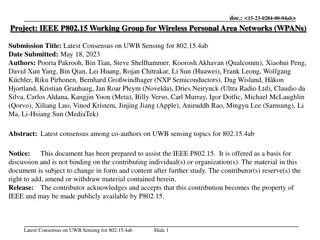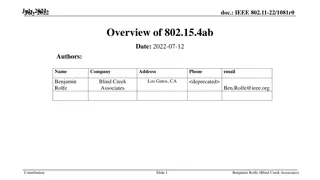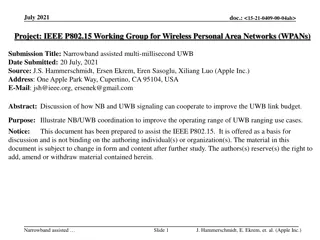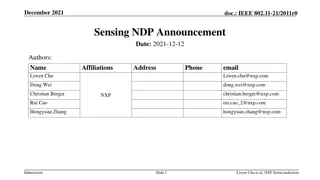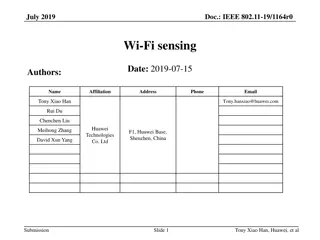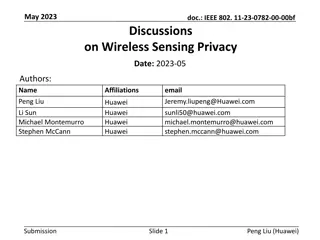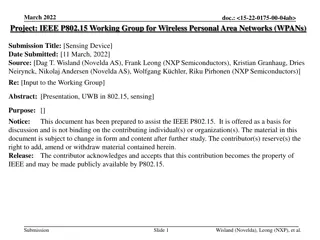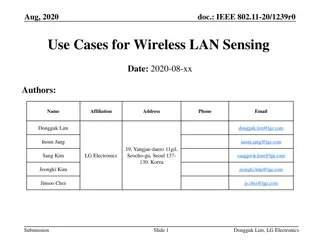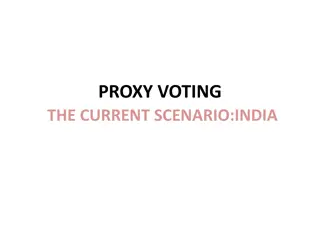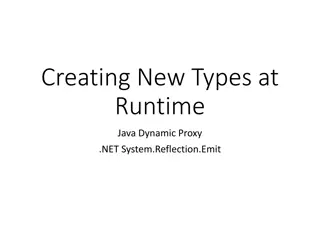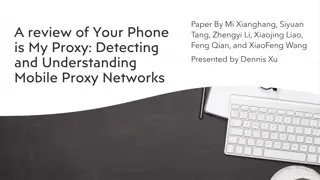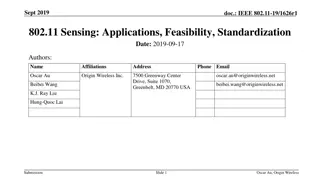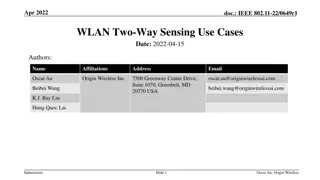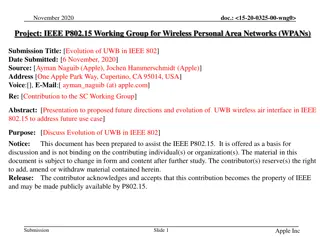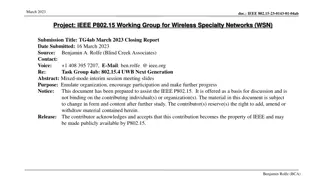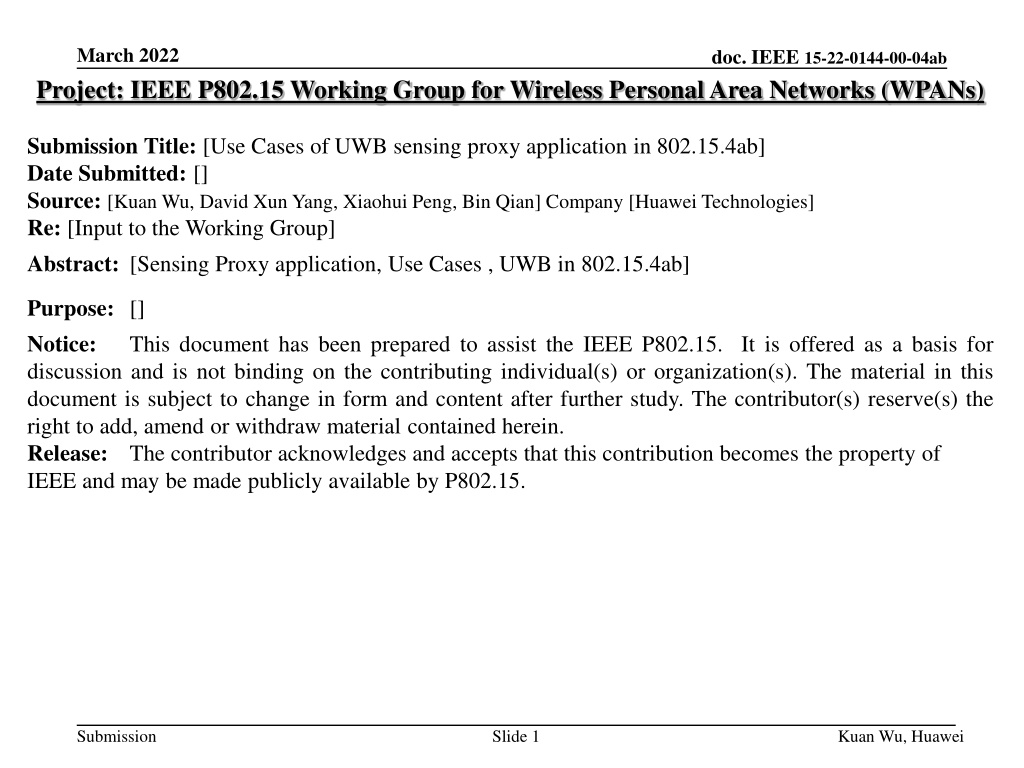
UWB Sensing Proxy Applications in IEEE 802.15.4ab Standard
Explore the potential use cases of Ultra-Wideband (UWB) sensing proxy applications in the IEEE 802.15.4ab standard. Learn about the modes, devices involved, and the purpose of UWB sensing proxies for presence detection and environment mapping.
Download Presentation

Please find below an Image/Link to download the presentation.
The content on the website is provided AS IS for your information and personal use only. It may not be sold, licensed, or shared on other websites without obtaining consent from the author. Download presentation by click this link. If you encounter any issues during the download, it is possible that the publisher has removed the file from their server.
E N D
Presentation Transcript
March 2022 Project: IEEE P802.15 Working Group for Wireless Personal Area Networks (WPANs) doc. IEEE 15-22-0144-00-04ab Submission Title: [Use Cases of UWB sensing proxy application in 802.15.4ab] Date Submitted: [] Source:[Kuan Wu, David Xun Yang, Xiaohui Peng, Bin Qian] Company [Huawei Technologies] Re: [Input to the Working Group] Abstract: [Sensing Proxy application, Use Cases , UWB in 802.15.4ab] Purpose: [] Notice: discussion and is not binding on the contributing individual(s) or organization(s). The material in this document is subject to change in form and content after further study. The contributor(s) reserve(s) the right to add, amend or withdraw material contained herein. Release: The contributor acknowledges and accepts that this contribution becomes the property of IEEE and may be made publicly available by P802.15. This document has been prepared to assist the IEEE P802.15. It is offered as a basis for Submission Slide 1 Kuan Wu, Huawei
March 2022 doc. IEEE 15-22-0144-00-04ab PAR Objective Proposed Solution (how addressed) Safeguards so that the high throughput data use cases will not cause significant disruption to low duty-cycle ranging use cases Interference mitigation techniques to support higher density and higher traffic use cases Other coexistence improvement Backward compatibility with enhanced ranging capable devices (ERDEVs) Improved link budget and/or reduced air-time Additional channels and operating frequencies Improvements to accuracy / precision / reliability and interoperability for high-integrity ranging Reduced complexity and power consumption Hybrid operation with narrowband signaling to assist UWB Enhanced native discovery and connection setup mechanisms Sensing capabilities to support presence detection and environment mapping Low-power low-latency streaming Use cases of UWB sensing proxy application in 802.15.4ab Higher data-rate streaming allowing at least 50 Mbit/s of throughput Support for peer-to-peer, peer-to-multi-peer, and station-to- infrastructure protocols Infrastructure synchronization mechanisms Support of peer-to-peer, peer-to-multi-peer protocols Submission Slide 2 Kuan Wu, Huawei
March 2022 doc. IEEE 15-22-0144-00-04ab Introduction UWB sensing proxy application is introduced in [1], where the use cases for proxy in 802.15.4ab need further discussion In this contribution, we discuss potential use cases for UWB sensing proxy application Submission Slide 3 Kuan Wu, Huawei
March 2022 doc. IEEE 15-22-0144-00-04ab Re-cap of UWB sensing proxy application [1] UWB sensing proxy application: a device can request the OTA CIR measurement report for sensing while not being initiator or responder Mode A: Initiator is the sensing receiver, responders are sensing transmitters Mode B: Initiator is the sensing transmitter, responders are sensing receivers Requesting device Requesting device Responder/Rx Initiator/Tx Responder/Tx Initiator/Rx Object Object Sensing request Sensing packet OTA CIR measurement report Mode B Mode A Submission Slide 4 Kuan Wu, Huawei
March 2022 doc. IEEE 15-22-0144-00-04ab Re-cap of ranging role structure in 802.15.4z [2] In multi-node ranging, a ranging procedure typically involves the roles of controller, controlee, initiator and responder The controller may not be necessarily an initiator or a responder In DL-TDOA [3], full-blown-satellites (FBS) are controllers, battery-powered-satellites (BPS) are initiators, smart tags are responders, respectively Observation: DL-TDOA scenarios share a similar role structure with sensing proxy. This can be a starting point for discussing UWB sensing proxy use cases. In the following, sensing mode A is used for illustration convenience. Submission Slide 5 Kuan Wu, Huawei
March 2022 doc. IEEE 15-22-0144-00-04ab Use Case 1 FBS are the sensing requesting devices BPS are the sensing initiators/responders Directly re-using the DL-TDOA role structure with minimized modifications BPS FBS BPS Requesting device Initiator/Rx Responder/Tx Object Sensing request Sensing packet OTA CIR measurement report Submission Slide 6 Kuan Wu, Huawei
March 2022 doc. IEEE 15-22-0144-00-04ab Use Case 2 Smart tags are the sensing requesting devices BPS are the sensing initiators/responders Coordination between BPS and smart tags may be needed, e.g. device discovery, synchronization and etc. BPS BPS Responder/Tx Initiator/Rx Smart tag Requesting device Object Sensing request Sensing packet OTA CIR measurement report Submission Slide 7 Kuan Wu, Huawei
March 2022 doc. IEEE 15-22-0144-00-04ab Use Case 3 Smart tags/FBS are the requesting devices BPS are the sensing initiators/responders A hierarchical proxy structure where FBS serves as primary proxy and BPS serves as secondary proxy, respectively Coordination between BPS and smart tags may be needed, e.g. device discovery, synchronization and etc. FBS BPS BPS Requesting device Responder/Tx Initiator/Rx Smart tag Requesting device Object Sensing request Sensing packet OTA CIR measurement report Submission Slide 8 Kuan Wu, Huawei
March 2022 doc. IEEE 15-22-0144-00-04ab Use Case 4 FBS/BPS are the sensing requesting devices Smart tags are the sensing initiators/responders FBS/BPS Requesting device Smart tag Smart tag Responder/Tx Initiator/Rx Sensing request Sensing packet OTA CIR measurement report Object Submission Slide 9 Kuan Wu, Huawei
March 2022 doc. IEEE 15-22-0144-00-04ab Use Case 5 Smart tags/FBS are the sensing requesting devices Smart tags are the sensing initiators/responders A hierarchical proxy structure where FBS serves as primary proxy and BPS serves as secondary proxy, respectively FBS/BPS Smart tag Smart tag Requesting device Initiator/Rx Responder/Tx Smart tag Requesting device Object Sensing request Sensing packet OTA CIR measurement report Submission Slide 10 Kuan Wu, Huawei
March 2022 March 2022 doc. IEEE 15-22-0144-00-04ab Use Case 6 Smart tags can be the sensing requesting devices, sensing initiators/responders Infrastructure is not directly involved in sensing measurement processes A device-to-device (D2D) sensing application scenario Smart Tag Smart Tag Smart Tag Requesting device Initiator/Rx Responder/Tx ?2 ?1 Object Sensing request Sensing packet OTA CIR measurement report Submission Slide 11 Kuan Wu, Huawei
March 2022 March 2022 doc. IEEE 15-22-0144-00-04ab Summary Responder Scenarios Requesting device Initiator Comments Use Case 1 FBS BPS BPS Re-use the DL-TDOA role structure with minimized modifications Use Case 2 Smart tags BPS BPS Coordination between infrastructure and smart tags Use Case 3 Smart tags/FBS FBS BPS Use Case 4 FBS/BPS Smart tags Smart tags Coordination between infrastructure and smart tags Smart tags introduce extra flexibility in extending sensing range Full flexibility regardless of infrastructure deployment in Use Case 6 Use Case 5 Smart tags Smart tags Smart tags Use Case 6 Smart tags Smart tags Smart tags Some proposals may be needed for further study Support for discovery between smart devices and devices/infrastructure Infrastructure may provide assistance for smart devices such as channel resource management support, synchronization and etc., especially in Use Case 6 of D2D scenario Support for efficient signaling designs to allow flexible operations between infrastructure and smart devices Coexistence designs between sensing proxy and DL-TDOA/UL-TDOA/TWR Submission Slide 12 Kuan Wu, Huawei Kuan Wu, Huawei
March 2022 doc. IEEE 15-22-0144-00-04ab Conclusion In this contribution, we identified several potential uses cases for UWB sensing proxy application Protocol designs on sensing proxy application to address the aforementioned use cases Submission Slide 13 Kuan Wu, Huawei
March 2022 doc. IEEE 15-22-0144-00-04ab References [1]. Pooria Pakrooh, Bin Tian, Steve Shellhammer, Koorosh Akhavan, UWB Sensing Scenarios for 802.15.4ab, 15-22-0012-02-04ab-uwb-sensing-scenarios-for- 802-15-4ab, January 2022 [2]. IEEE Standard for Low-Rate Wireless Networks Amendment 1: Enhanced Ultra Wideband (UWB) Physical Layers (PHYs) and Associated Ranging Techniques, IEEE Standard 802.15.4z-2020 (Amendment to IEEE Standard 802.15.4-2020), IEEE SA, pp. 1 174, Aug. 25, 2020 [3]. Jean-Marie Andr , Sven Zeisberg, DL-TDOA positioning TDMA scheme, 15- 21-0530-00-04ab-dl-tdoa-positioning-tdma-scheme, October 2021 Submission Slide 14 Kuan Wu, Huawei

